Bees, beetles, butterflies, birds, blooms–all are the big Bs of wildlife gardening and my garden was chock full of them this past month. Welcome to Wildlife Wednesday, celebrated on the first Wednesday of each month by and for gardeners who cherish wildlife in their gardens.
It was the good, the bad and they ugly in my gardens this past month. A crew of icky aphids set up an all-you-can-eat diner on the foliage of some of my Frostweed, Verbesina virginica. I’ve never seen the Frostweed host these damaging insects before–until this spring.
I hit the foliage with a stream of water three different times within the span of a few days to knock off the aphids and by then, the good guys, Lady Bird Beetles like this Seven-spotted Ladybird Beetle, Coccinella septempunctata, and their larvae moved in for the kill. Or, rather, the meal.
Or, rather, the meal.
The adults eat, but their larvae, typical of all kids, eat more. These little alligator-looking Ladybird Beetle larvae contentedly munched away at their favored food, the squishy, juicy aphids.
The aphids are gone now, thank goodness, and the Frostweed is on its way to its autumnal glory.
Lady Bird beetles have made themselves at home on other plants too–presumably because what they eat (like aphids) have been abundant this spring. They hunted on the wildflower, Lyreleaf Sage, Salvia lyrata,
…where you can see the aphids amidst the eating beetle. I’ve also seen plenty on fennel which I plant primarily for the Black Swallowtail, Papilio polyxenes, butterfly larvae, like this well-fed beauty.
Once the Ladybird Beetle larvae eat-n-grow and complete their four larval molts, they pupate, like this one,
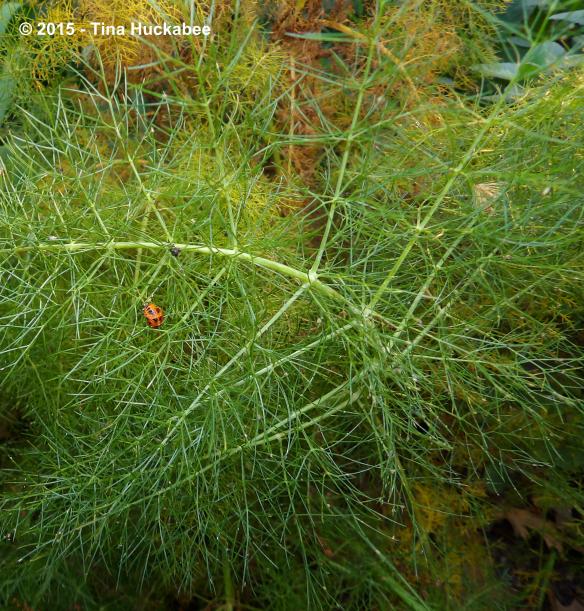 …to become adults, like these two.
…to become adults, like these two.
Last month, I identified this excellent garden companion, the Horsefly-like Carpenter Bee, Xylocopa tabaniformis.
I’m charmed by these bees–they possess a je ne sais quoi, which is unexpected in a bee.
These native bees are common in my gardens, working blooms from sunrise to sunset.
I love watching them in my garden, though I’ve had trouble photographing them because they’re so active–zooming up, down, and all around. I’ve finally captured a couple of good shots and would you take a look at those baby-blue eyes,
…and that cute face,
…especially when playing hide-n-seek with me.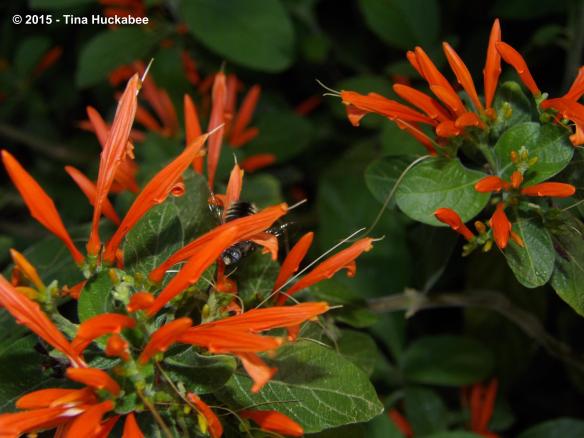
I think Paul Newman would be jealous of their beautiful peepers.
Bees are the bomb in any garden. This native Sweat Bee, maybe a Augochloropsis metallica(?), was only willing to show her abdomen while she pollinated a native wildflower, a Spiderwort, Tradescantia, ssp.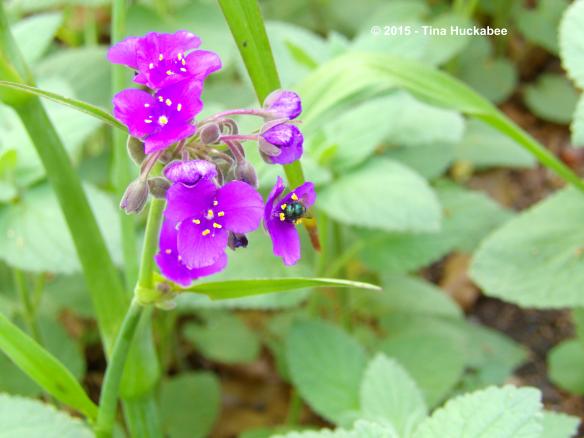
But the Metallic Green bee, Agapostemon texanus, on the open Winecup, Callirhoe involucrata, worked intently and not shyly while gathering pollen for her offspring and nest. She performed admirably for me and my camera.
I particularly like this shot. Head stuck deep in the pollen center of the flower, with only the abdomen and splayed back legs visible. There’s also a tiny companion ant on the flower.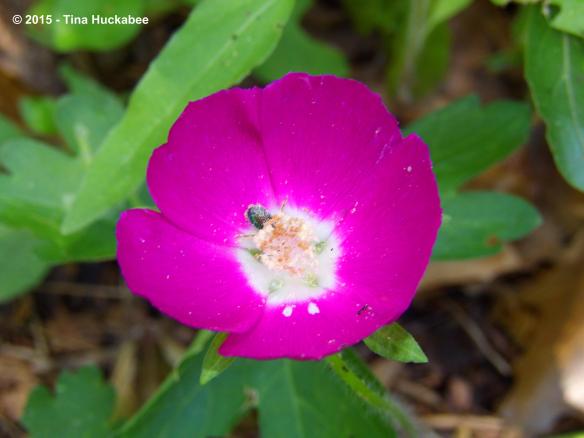
I gave up on an identification of this pollen-covered bee, though I suspect it’s some kind of carpenter bee. The medium to large size, dark/black coloring and relatively hairless body are good general descriptors of carpenter bees.
I watched her crawl around the blooms of a Globe Mallow, Sphaeralcea ambigua, one Sunday afternoon and was impressed at the amount of pollen she gathered on her body. How does she fly and see with all that stuff on her body and in her eyes?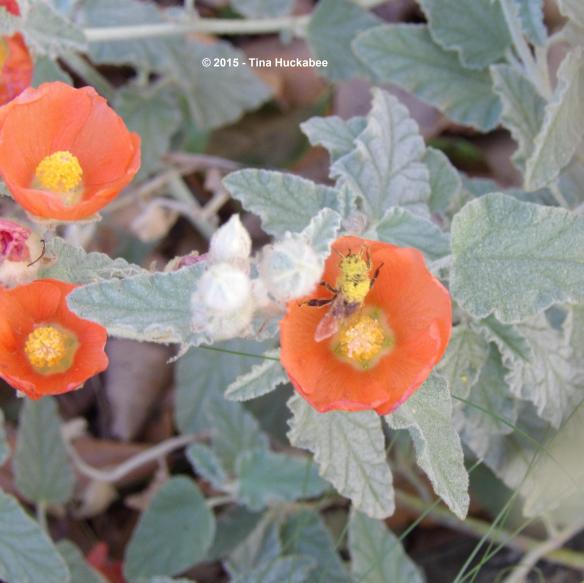
If you know what this bee is, give a holler; I’m stumped, but glad she’s visited!
I think the wildlife plant-of-the-month award goes to the Engelmann or Cutleaf Daisy, Engelmannia peristenia. It’s currently serving as Syrphid Fly central,
…providing nectar for the adults, also known as Flower or Hover flies, and aphids for the larvae, which are little green to creamy-yellow worms.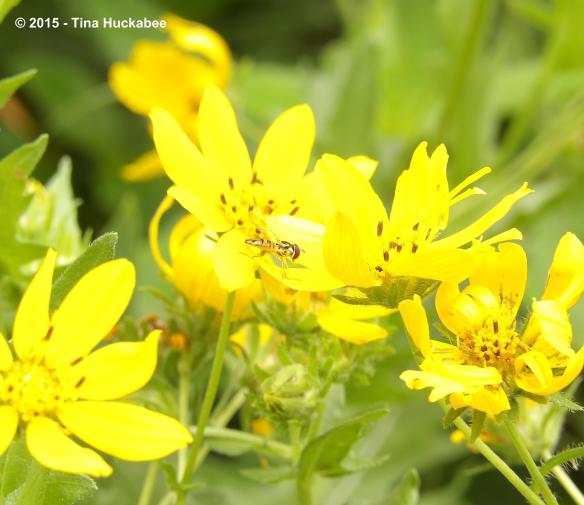
These are beneficial insects, so you want them visiting your gardens.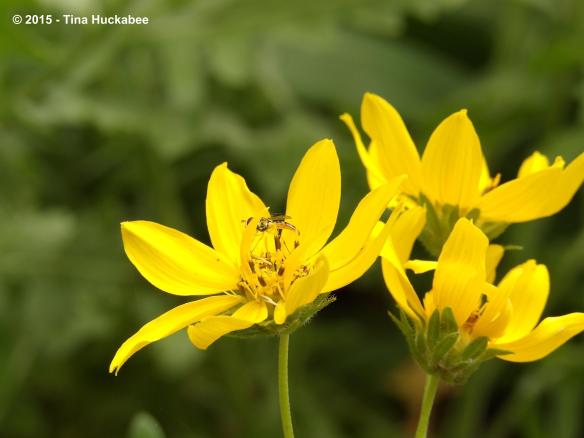
Besides, look how pretty they are–both the flowers and the insects.
This guy,
…a “true bug” or Hemiptera and in the Family Coreidae or Leaf-footed bug, is a Spot-sided Coreid, Hypselonotus punctiventris, and also liked my Engelmann Daisy. I don’t think he’s someone I really want on my plants, though it looks to me like he’s in a nectar-sipping mode, rather than a sucking-the-life-out-of-the-plant mode.
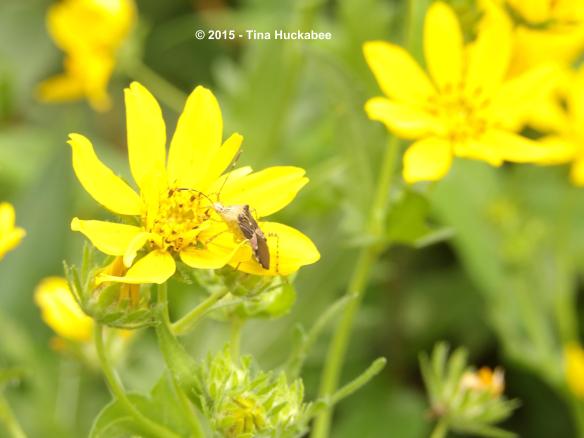 He’s dashing in his brown tuxedo.
He’s dashing in his brown tuxedo.
The Engelmann Daisy in my garden has attracted Ladybird Beetles and their offspring and at least five types of bees, as well as visits from butterflies. It’s a good wildflower and wildlife plant. Since it’s National Wildflower Week, I think Englemann Daisy deserves a huzzah! for its usefulness and beauty in the home garden.
Of course butterflies are happenin’ pollinators this month, as well. This pretty Gray Hairstreak, Strymon melinus, appears to enjoy the nectar benefits of the native wildflower, Zexmenia, Wedelia hispida. The host plant for the Grey Hairstreak includes mallow and pea family plants, but the adults will nectar on a variety of blooms.
This attractive butterfly, a Mournful Duskywing, Erynnis tristis, doesn’t look particularly mournful to me.
In fact, this little fella looks as if he’s challenging me because I’m wanting him to pose prettily.
Or maybe I disturbed his smooth-moves with a lady-friend.
The host plant for his kind includes a variety of oaks and they breed in Texas three times per year. I’ll leave you to it, M. Duskywing–I like seeing you and your bunch around my gardens during the summer.
I observed a bird that I’d never seen before, flitting between my Shumard Oak tree, just above where my honeybee hives are located, and a neighbor’s tree. Because he was shy, this was the best photo I could get. Look at that color!!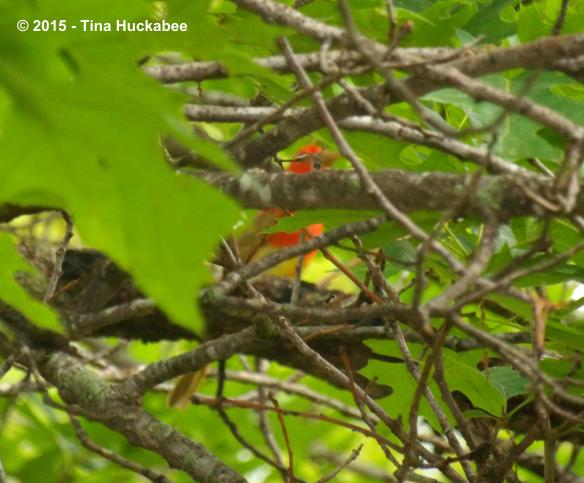
This gorgeous thing is a juvenile male Summer Tanager, Piranga rubra, and is North America’s only truly red bird. They breed in Texas, though I’ve never seen one before; it may have been passing through or perhaps he lives in a nearby area. I wondered aloud why he kept returning to the oak tree and The Husband offhandedly suggested that maybe the Tanager eats bees. I whipped out my phone and checked the Cornell Ornithology Merlin app and read about this eye-poppingly beautiful bird. Indeed, they hunt bees and wasps! They catch the bee as they fly (both bee and bird), hit the bee on a branch (ouch!!) to kill it, remove the stinger and chow down on bee/wasp. My poor honeybees–that’s why the bird was hanging around! But that’s the natural world–not necessarily pretty, tidy and well turned out, but always interesting.
I hope your gardens benefitted from wildlife visitors this month and that you will join in posting for May Wildlife Wednesday. Share the rare or mundane, funny or fascinating, beneficial or harmful critters you encounter. When you comment on my post, please remember to leave a link to your Wildlife Wednesday post so readers can enjoy a variety of garden wildlife observations.
Happy wildlife gardening!

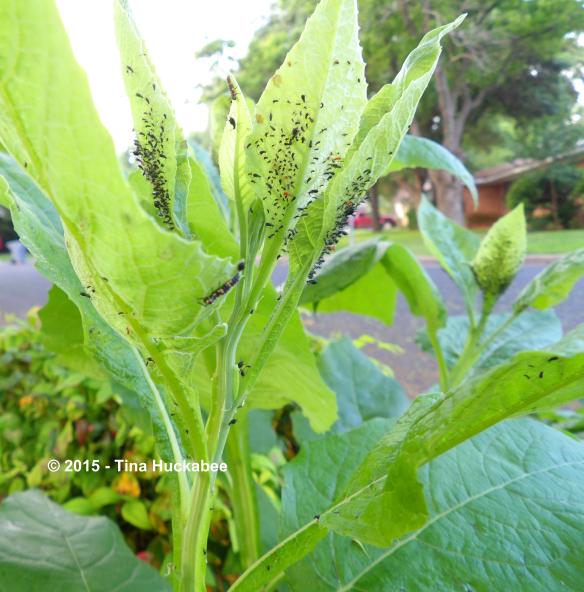
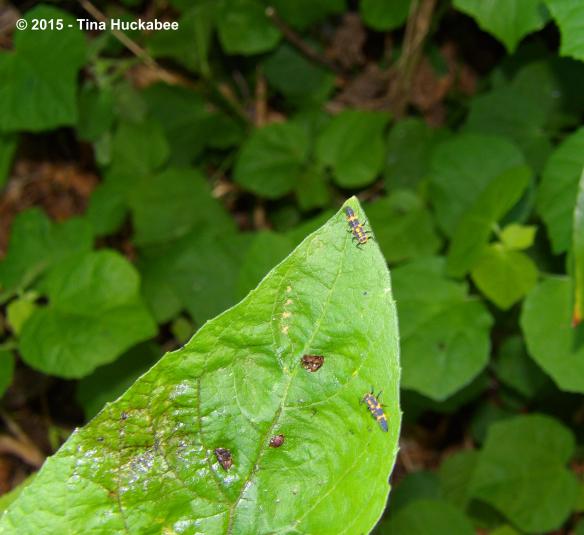
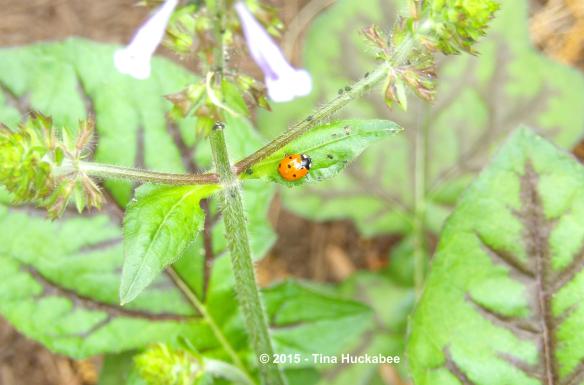
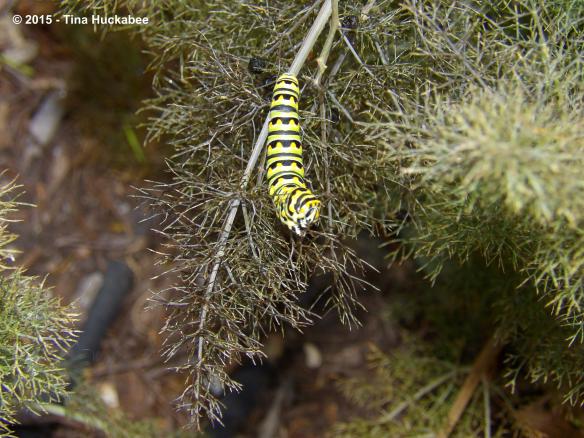
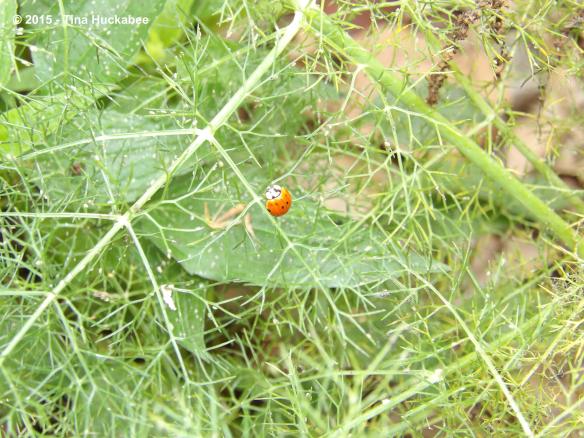
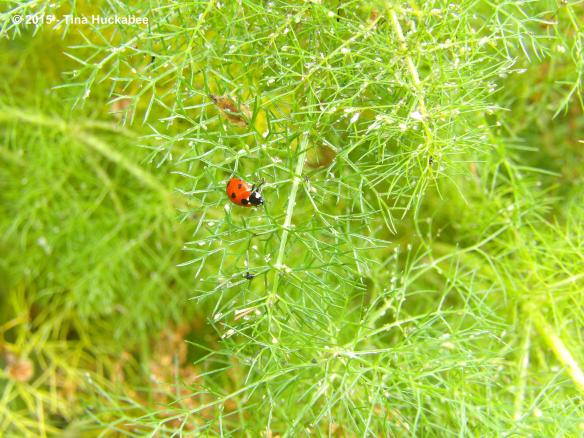
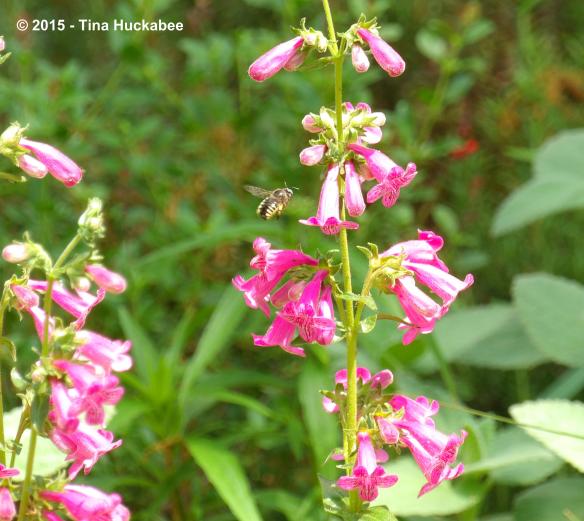
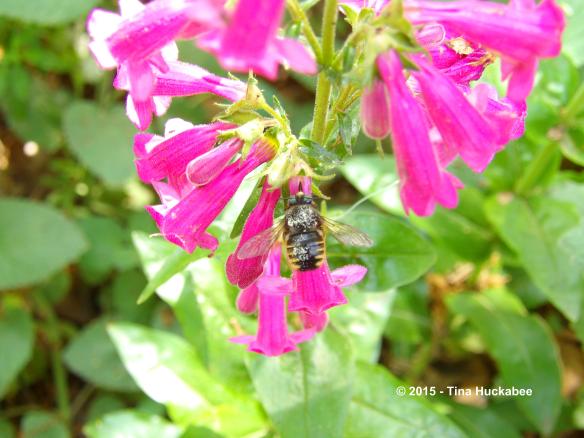
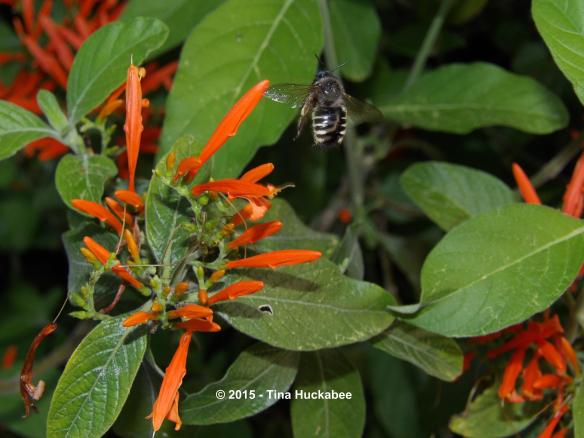
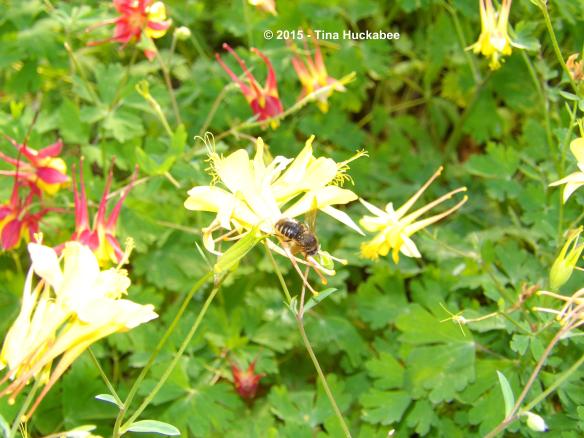
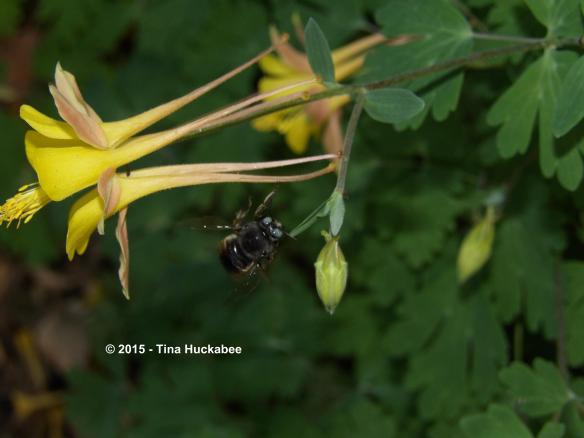
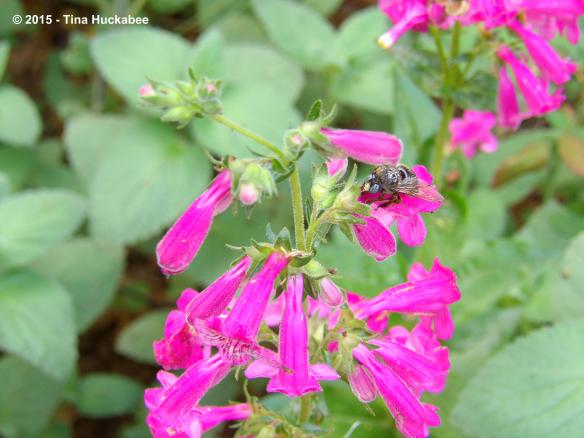
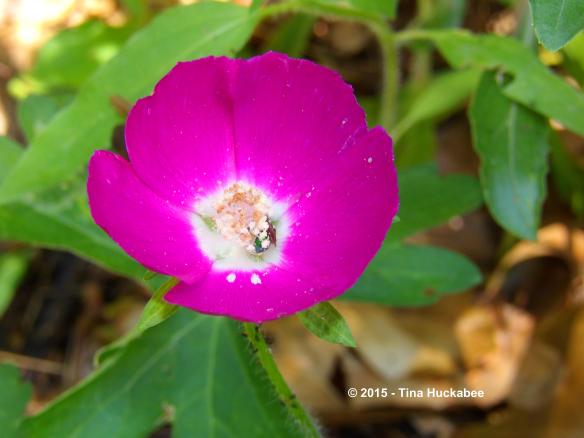
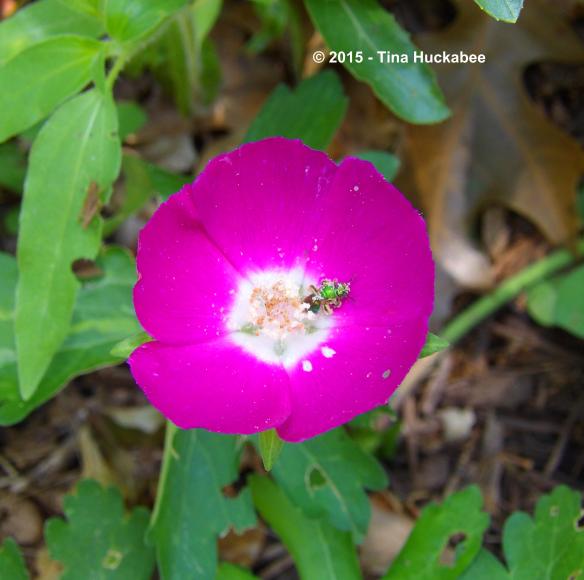

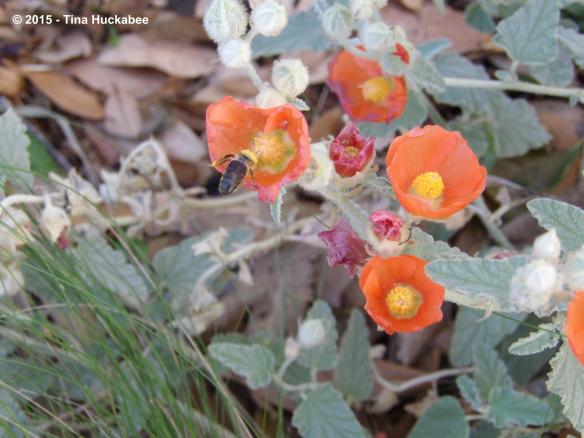
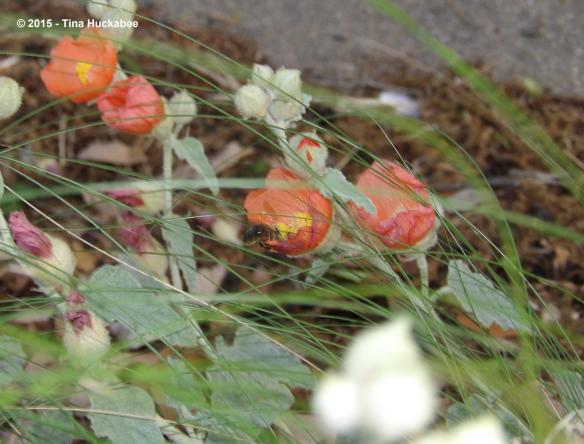
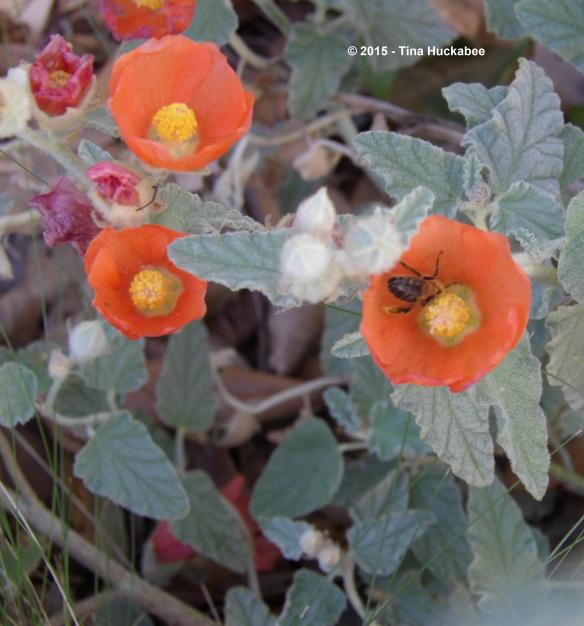
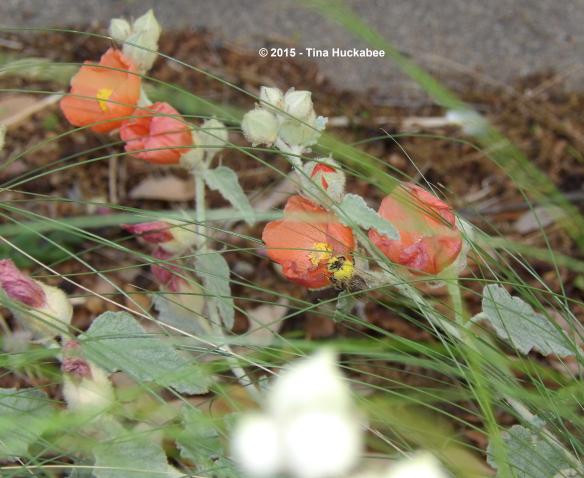
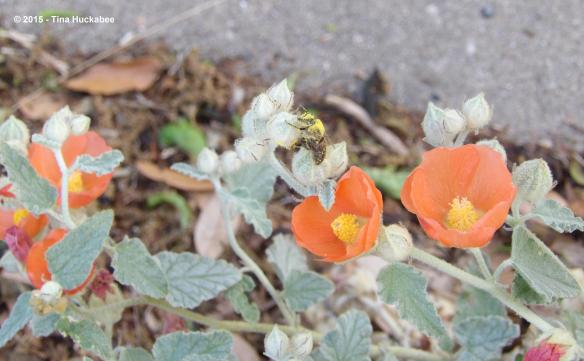
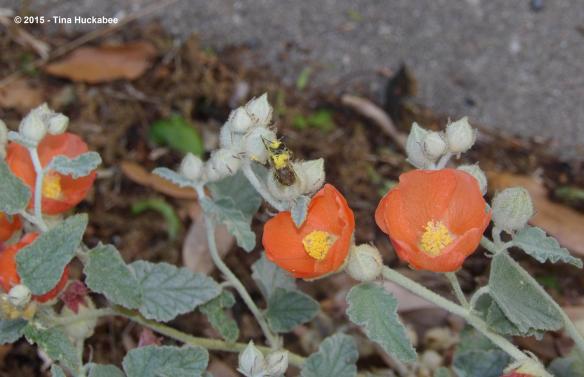
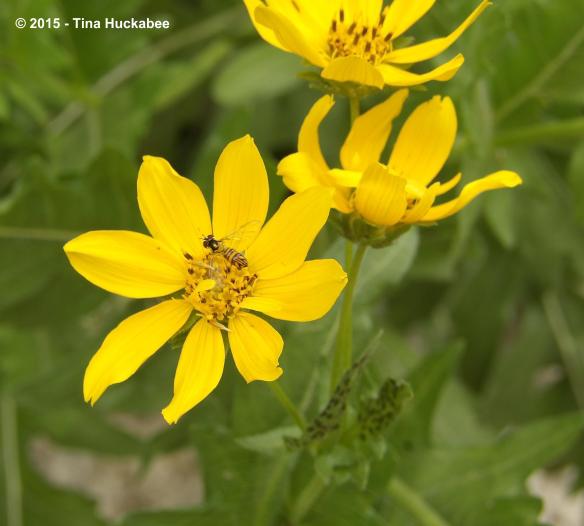
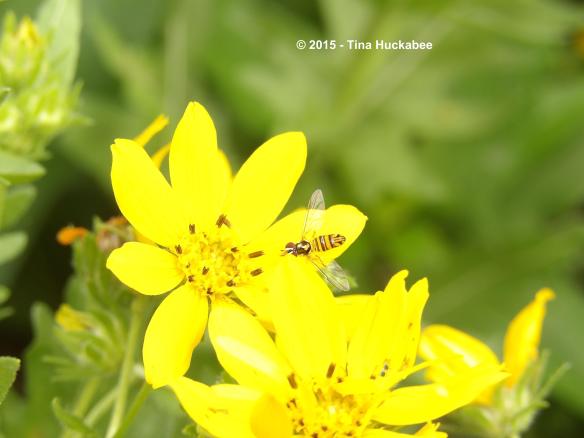

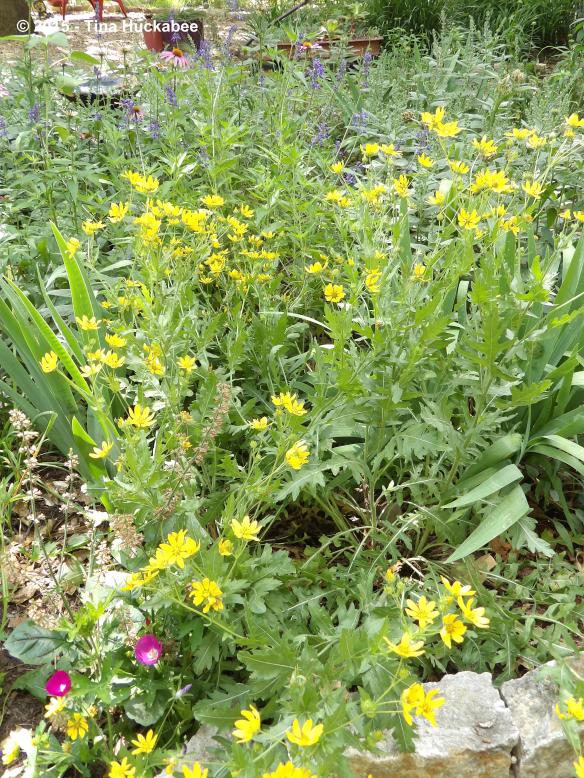
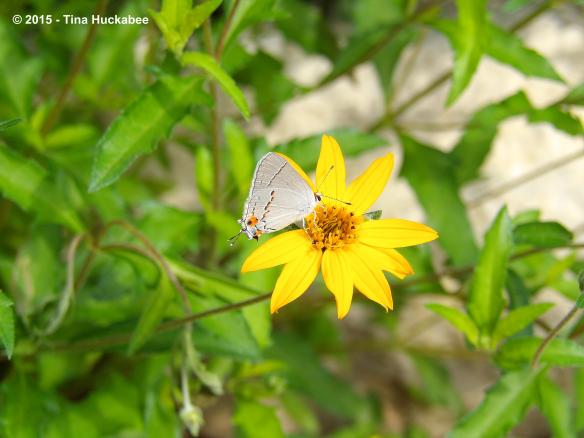
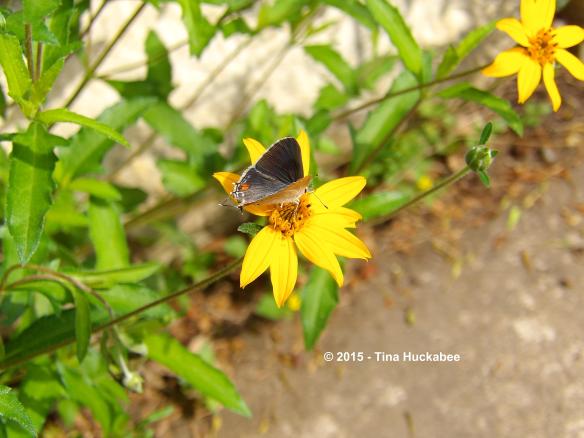
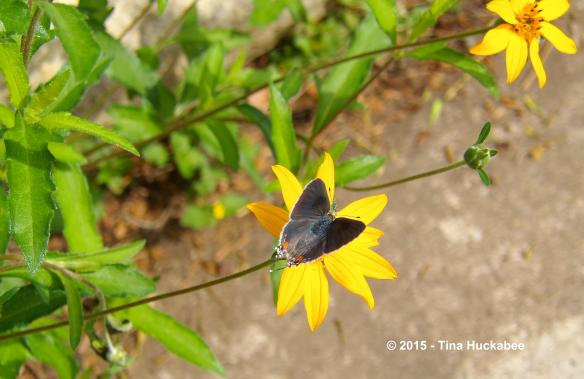
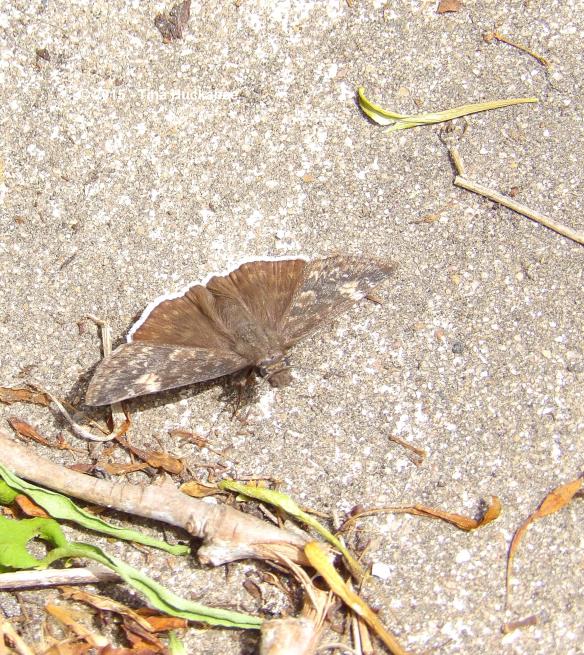


Pingback: Wildlife Wednesday – Looking back at our April Wildlife Visitors | Gardening Jules
Hi Tina, Can you tell me how you saw my post, currently going around in circles, as its not coming up on my reader and WP says it was published 19hours ago.
LikeLike
I follow you, so your posts come in my email. I just realized that your post was dated May 5th. Hmm.
LikeLike
I have only just put a “ping back” link about 20 minutes after you published your post. Our internet speed is less than one, just to upload photos takes an age, hence my ‘you can’t be serious moment’. I tried to reblog but WP would not let me do that either. I shall go outside for instant calmness!
LikeLiked by 1 person
Anyhoo! Going back to your post which is absolutely lovely. I also have 7 spots ladybirds and well done on at least most of your bee identifications, I find it quite tricky to decide. The Engleman daisy is really pretty, I guess thats a native to you as I have not seen it over here or at least I do not think I have. Off to try and sort my link out to your meme. https://gardeningjules.wordpress.com/2015/05/05/wildlife-wednesday-looking-back-at-our-april-wildlife-visitors/
Funnily enough I read an article in the middle of the night…..could not sleep, about putting too many tags on and then WP not putting posts in a reader, I think I went giddy and tagged too much.
Thank you so much too Tina for hosting this meme.
LikeLike
The bee identifications are really a work in progress for me. Sometimes, I get them immediately, but that’s not usually the case. The Engelmann is lovely–I always forget what a great late spring bloomer it is and it’s a fabulous wildlife plant. I have a couple of seedlings and need to find better spots for them.
Sometimes, the technical parts of this blogging biz are a real pain. My sympathies!
LikeLiked by 1 person
I imagine you have even more species of Bee than we do here, I am starting to recognise some of our Bumblebees but I find solitary bees very tricky and of course there are so many other insects to identify. Your meme is a wonderful way to be introduced to even more species from across the world. 🙂
LikeLiked by 1 person
Huzzah indeed! Here’s to your Englemans and your great captures of visitors. You must be so pleased on all counts…the garden, the wildlife, and your photographic success. Garden blogger hat trick!
I can’t ID your bee but am happy to know Mr. Brown Tux’s real identity since I’ve had several of his cousins visiting here. I’ll keep an eye out for any moves from nectar to sap sucking. They are handsome devils, but no free rides for plant eaters here, even good looking ones.
Speaking of handsome – what a gorgeous bird! I’m so sorry to read he is after your bees. Knowing who is what and what they are after can be so conflicting! I don’t want a bird to starve but I’m not thrilled with the thought of it out chasing down already beleaguered bees. Glad it isn’t up to me to decide how that story will shake out.
Here’s a link to my WW post for this month. Happy Wildlife Wednesday, Happy May and Happy Mother’s Day!
http://austinagrodolce.blogspot.com/2015/05/parents-in-wild-happy-mothers-day.html
LikeLike
Insect identification is for folks with more patience than I. As for Mr. Tux, I looked at all sorts of categories of “beetle-like” critters, thinking that , “Oh, he’s not a leaf-footed.” Of course he is….
As for the Tanager, well, bummer for the bees, but I was glad to see this bird. I’m generally philosophical about the cruelties of nature. Generally.
LikeLike
Btw, you’re spot on about flies–beautiful and important pollinators. I guess I’d better start learning how to ID them too. Oh nooooooooo. 🙂
LikeLike
Such a lovely post with great photos of all your beautiful wild flowers and insects. You know your bees alright. I am alarmed each May by all the carpenter bees which appear in my house. I am worried that they are somewhere in the roof space chomping on my 500 year old beams. The other bees are very welcome, we have some massive bumble bees around this year. I have only just learnt that there are 25 different bumble bees in the UK so I have a lot to learn.
LikeLike
Oh, I’m jealous of your 500 year old beams and your bumbles! I hardly ever see bumble bees anymore–very sad, I think. I do seem to have lots of other species though and I’m glad they have a welcome in my garden.
My son is currently in Britain studying and he will laugh about visiting a pub or eatery that is older than the U.S. So cool.
LikeLike
Hi Tina — Congratulations on your bee photos. It’s so difficult to capture bees because they never seem to sit still, but your pictures are great. The Summer Tanager is so pretty! Lucky you for seeing him. It looks like we had a few of the same visitors again this month — the Gray Hairstreak and the Hoverflies. I sometimes wonder what my neighbors think when they see me running around the yard, aiming my camera at the ground!
Here’s my link for this month — https://transmutationalgarden.wordpress.com/2015/05/06/wildlife-wednesday-may-2015/
Thanks for hosting!
LikeLike
I would imagine that we share lots of the same species of birds and insects, though you seem to have a greater variety of birds in your gardens. I think my neighbors respond to me much like they always have done–with a bit of eye-rolling.
LikeLike
Pingback: Wildlife Wednesday: May 2015 | Under the Pecan Leaves
As I’ve come to expect: beautiful photos. Thank you =)
❤ the carpenter bees. They have the cutest faces and will play fetch. I finally learned how to identify the Engelmann Daisy last night thanks to a nice wildflower walk hosted by the Lady Bird Johnson peeps for Wildflower Week. I had admired the flowers from afar but wasn't sure about what to call them. And amusingly one of the experts mentioned in passing something about yellow composites being tough to ID. I am not alone! They really are the sparrows of the flower world. And though it must be tough for your bees to have a terminator perched above I have to admire your tanager. wow wow wow
I was a little slack at gathering photos this month. Nothing exotic just a roundup of the usual suspects https://mylandrestorationproject.wordpress.com/2015/05/06/wildlife-wednesday-may-2015/
LikeLike
Thanks, Debra. Those carpenter bees–I’m quite smitten with them and am so glad they seem to like me and my garden, as well.
There are TONS of “yellow daisy-things”, which is what I call them. A bunch. I don’t know where I got my Engelmann, either BSN or WC’s sale, but it’s seeding out, so yeah, great plant all around. My only beef with it is that it doesn’t bloom all summer.
LikeLike
Oh, nifty that you got to see a Summer Tanager! I’ve seen a few (very few) Scarlet Tanagers over the years, but never a Summer Tanager. Great wildlife shots–especially the blue eyes of the Carpenter Bee! Wow! Excellent!
LikeLike
I’ve only seen a Scarlet once, about a year ago. Beautiful! The Summer was gorgeous too–I’d love to see him again. I enjoy those Horsefly-like Carpenter bees and they seem to tolerate me, so hopefully, more blue eyed-bees in this blogger’s future!
LikeLike
Just under the wire! It is still Wednesday! You have found so many bugs and bees in your garden and are much better at identifying them.
http://rockoakdeer.blogspot.com/2015/05/wildlife-wednesday-april-2015.html
LikeLike
You are most welcome to post whenever you can, Shirley–always glad to have you aboard.
LikeLike
Wow Tina that is quite a garden of delightful insects and critters….I love seeing those Ladybugs do their job and enjoy the aphids. And so many pollinators. The yellow daisy is new to me but I love hearing about all its wonderful attributes. Here’s to our wildflowers and wildlife! Thanks for hosting!!
I am linking in today with a visitor from about a month ago new to us….
LikeLike
Yay for wildflowers!! Yes, there are lots of happy and busy pollinators in my gardens these days.
LikeLike
I gave you the wrong link for my wildlife post…sorry…
http://www.livingfromhappiness.com/wildlife-lessons-seeing-red/
LikeLiked by 1 person
This is a really wonderful post and I know it took a lot of time to put together… Michelle
LikeLike
It was fun and I really appreciate how much wildlife is visiting or residing in my patch of the Earth. Thank you for reading!
LikeLiked by 1 person
You really saved the best for last on this one. That summer tanager is gorgeous. I’ve certainly never seen one, so I hope he/she visits you again so you have even more pictures to share. Non-wildlife related question… where did you find your frostweed? I’ve been searching for it in local nurseries for the past several months and they all look at me dumb when I ask about frostweed. Is it something you have to grow from seed? Here are my B’s for the month… birds butterflies, bees and bugs http://rebeccastexasgarden.blogspot.com/2015/05/wildlife-wednesday-may-2015.html
LikeLike
The Tanager story is even better: it’s a mated pair that is hanging about and eating bees. I spent WAY too much time watching them yesterday, but wow, what a treat. I just hope they don’t eat all of my honeybees…..
LikeLike
Okay, so I posted this on the homepage by accident, let’s try this again! Here is my (11 year old) daughter’s first post from May 2015! Thanks for hosting such a fun meme! Her post is quite imaginative 🙂
LikeLike
Great and thanks! I’m tickled that your daughter is so interested and I hope she gets lots of hits for her fun and well-written post.
LikeLiked by 1 person
Some kind of nasty mite has attacked and severely damaged two stands of phlox. Jerks. But aside from cutting down the stalks that had been killed, I’m leaving them alone. The good guys will show up to eat the bad guys and if it’s too late, I’ll just cut them back. Love all these wildlife photos!
LikeLike
They are big jerks! Sometimes I wish the good guys would show up just a little more quickly than they do. Regardless, I’m please when they decimate the bad guys. I’m pro-carnage, in certain situations.
LikeLike
How wonderful, what a lovely selection of insects and information. Following as really interested in your blog. 🙂
LikeLike
Thank you, Gaia! There are so many wild “things” to learn about–a life-long adventure!
LikeLiked by 1 person
I certainly agree and enjoy it very much too, everyday there is something new or different in nature, it is so stimulating, and to take photos of it I love too.
LikeLiked by 1 person